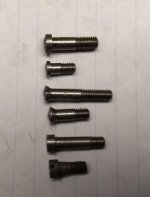Hi Spooky:
I make screws for a customer on a simple gang chucker with C axis; here's my experience.
The cycle time of single point threading is uncompetitively slow if, and only if, you intend to sell at comparable prices to the price you'd pay to buy standard screws in a box.
Since you're not and since you can ask a premium for your screws because they're presumably unavailable anywhere else, there's no reason you can't make a nice profit on these.
However, you must understand your costs and your desired profits to make a good judgement about price, and that depends on whether you intend to stock common screws in buckets for eventual sale or do custom orders only.
(It depends on other things too, but this is a good starting point).
This brings me to technical considerations.
I make the same four screws over and over in batches of 25 at a time, so my method reflects that pattern and I have refined it so it's a nice little sideline for me.
My tooling is all set up so I have one tooling block to mount on the slide and one offset to touch off in order to have everything ready to run.
Since my driver slots are sinker EDM cut (they're a shape that cannot be milled) I have fixtures to mount 25 screws into and a standard gang electrode to burn 25 at a time.
I use a bar puller (way cheaper than a bar feeder) and a spindle liner so I can run blank screws autonomously and just go and collect my stuff when the machine stops after a run; I qualify the first, tenth and last screw of each batch and the sub program I wrote is restricted so I can only make a modest number of screws before the machine stops and I check one before I push the big green button again.
That way I will only ever lose a few screws if I break a threading tip or have some other misadventure...cheapo QC, but it works for this job.
I can turn a single 4:40 x 0.250" long buttonhead screw blank in under a minute in 303 stainless steel, so they are sub-$2.00 blanks.
I know I don't sell enough in a year to justify a Swiss or even a run on someone else's Swiss; my customer takes a few hundred of each off my hands every year, so even if I cut the price of the blanks in half by outsourcing them I'd save a hundred bucks or so...not worth the hassle to have someone else run the blanks for me at any price.
Slotting them is the expensive step and that is where the profit is.
Your case is totally different.
You can run the screws backward so you can slot or broach right on the turning center but still take them off the bar in one operation.
So you'll need a C axis machine and you'll need a single live tool if they're going to be sawn slots
If you can cut the slots with a little shaper blade you still need the C axis but not the live tool.
So your machine needs are modest; no subspindle, no Swiss, no guide bushings, no centerless ground bars; but ONLY if your screws are mostly shorties that can effectively be run on a simple 2 axis machine.
I'm using a SNK Prodigy 5C gang chucker I paid fifteen grand for and it's a nice little machine for the work.
There are a gazillion 5C gang chuckers out there; DD Machine recommended an Omniturn and they're a perfectly reasonable choice but there are lots of others too.
As an aside, when it's time to go machine shopping, I'd be inclined to stay away from Dynamic CNC; they're enjoying a particularly bad reputation right now for non-delivery of machines they've taken payment for.
Whether justified or not, it's just an uncertainty you don't need to embrace when there are so many other places you can get a machine; these things are common as dirt.
There's a recent tale here on PM that's a real tale of woe, and the complainant sounds like he's telling the truth, so do a search, read the story and make a judgement for yourself
So expect a tab comparable to what I spent in order to get the ability to make these; expect to be able to make a screw profitably for somewhere under $3.00 for a short simple slotted screw for just the turning and slotting, and decide if it's worth it to get in the game.
You'll need to sell a lot of screws or sell them at quite a high price per screw to put a happy smile on your face, but if you can satisfy yourself it's worthwhile, there's no technical reason you can't make it happen and you don't need exotic machines to do it.
If you intend to make customs expect to spend a half a day to program, set up, and first article a part...be sure to price that reality into your custom screws.
Batches, repeat orders and stock items are different.
Cheers
Marcus
Implant Mechanix • Design & Innovation > HOME
Vancouver Wire EDM -- Wire EDM Machining



